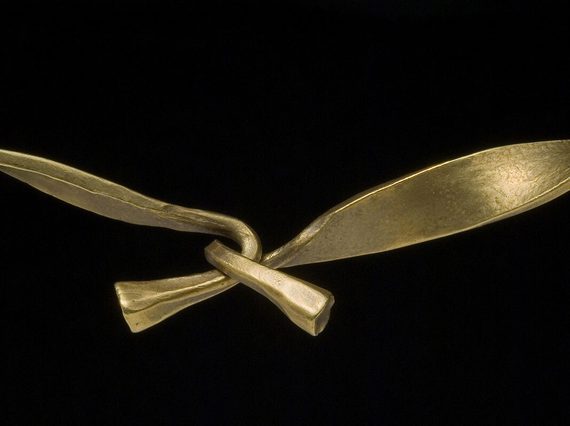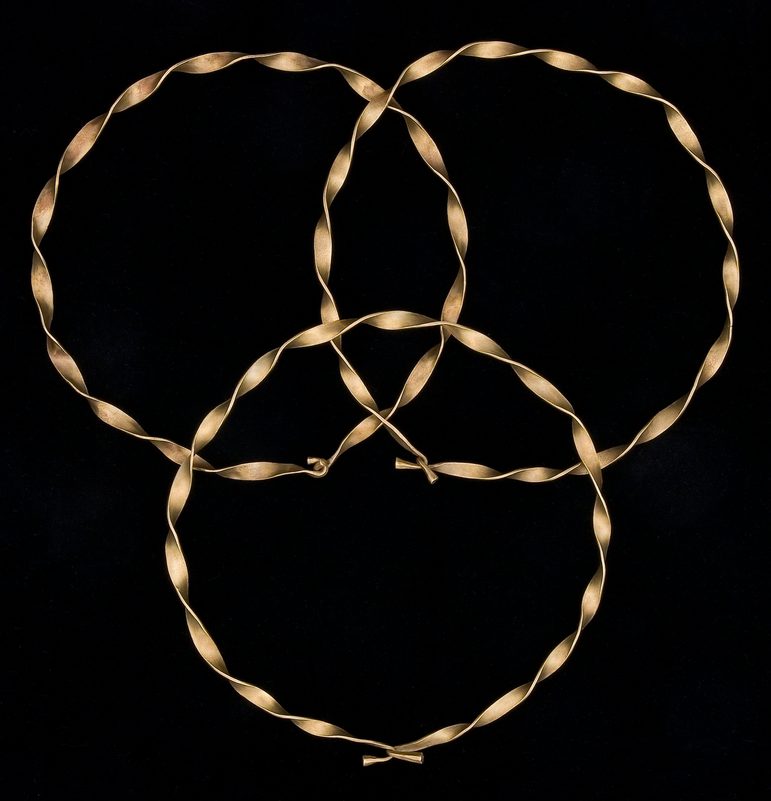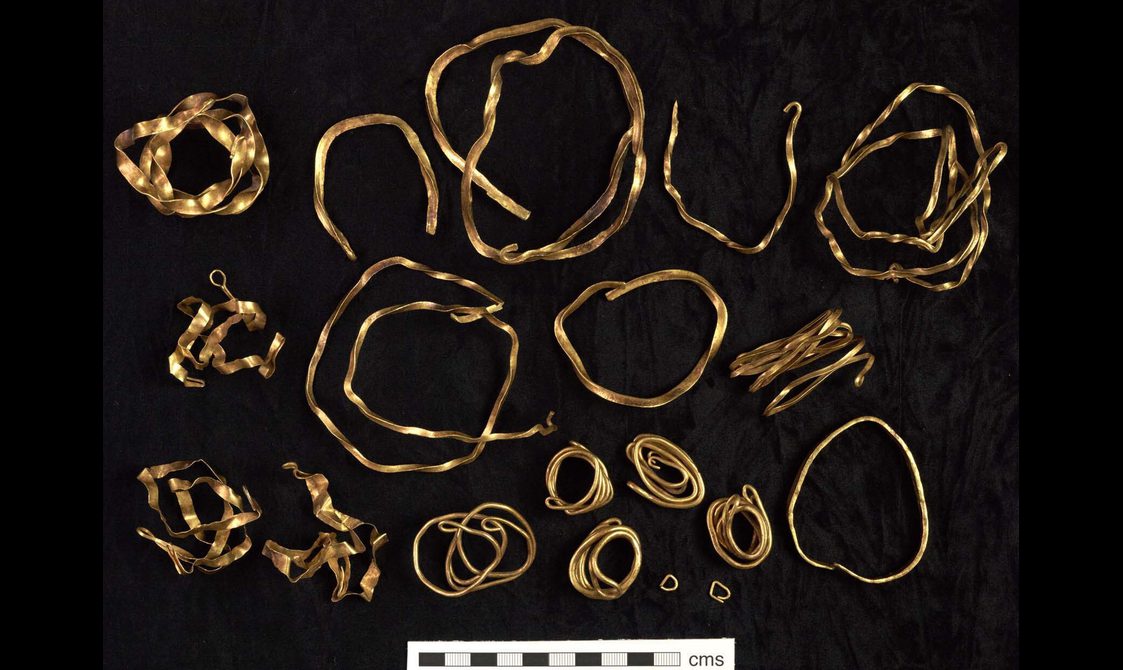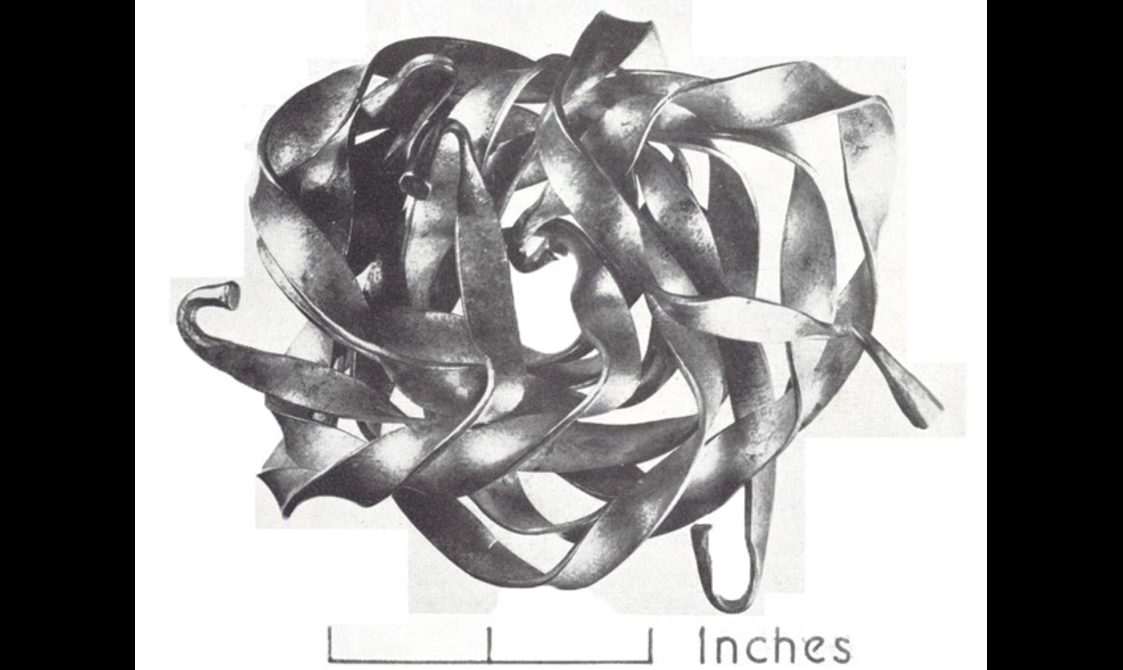
The Heyope Hoard
We like to imagine that Bronze Age communities treasured and protected their gold objects; after all, if you have a beautiful piece of jewellery like a hair ring or a lunula, it deserves to be looked after. But this was not always the case.
This hoard of three Middle Bronze Age torcs (or neckrings) was found by a farmer in Heyope, Powys, in mid-Wales in 1955. These objects were buried entangled and crushed, preventing the objects from being used as intended. The big question, which we’ll come back to further down, iswhy?

The torcs have since been reconstructed and restored to their presumed original form so we can clearly see that the Heyope torcs were produced from a loosely twisted thin ribbon of gold that tapers to narrow hooked terminals. These terminals would have interlocked to secure the torc around an individual’s neck. The diameter of the torcs is around 216mm, so they would have been a snug fit around the neck, worn like a choker.
Image gallery



Ribbon torcs of this design typically date to the Middle Bronze Age (1400–1275BC) and the Heyope torcs are the only complete examples from Wales. A fragment of ribbon torc has been found with four Bronze Age bracelets in a hoard from Capel Isaf, Powys, and other ribbon torcs are known across Britain and Ireland. However, we have to be careful with dating ribbon torcs as they were also produced in the Iron Age: all of the examples found in Scotland and Ireland are definitely or probably of Iron Age date. These later examples are more tightly twisted and generally have more elaborate terminals; their gold composition also differs from that of the looser-twisted Middle Bronze Age examples. While the Heyope torcs have not yet been analysed, their design is consistent with a Middle Bronze Age date and this ties in with the overall pattern where examples south of Scotland and east of Ireland belong to that period.
Returning to the deliberate deformation of the Heyope torcs, the Capel Isaf hoard mentioned above is particularly interesting as the objects were buried in a “tight mass” and “wrapped round each other” (Savory 1977, 37), suggesting there were similar ideas about how objects should be treated and confirming that a Middle Bronze Age date is accurate for Heyope. Moreover, a hoard of seventeen gold bracelets and torcs was recently found at Priddy, Somerset; these objects, including multiple ribbon torcs, were also buried in a crushed ball.
So what does this all mean?
Torcs and other gold ornaments were status symbols. They were designed to demonstrate wealth and power. The wearer may have been a leader of a community or part of an important lineage or kinship. Basically, if you saw someone wearing one of the Heyope torcs, you’d know they were a big deal!
So why crush and bury them?
First we have to think about who was destroying and burying the Heyope hoard. Was it one person? Or a group of people? The hoarding and burial of ornaments was popular in the Middle Bronze Age and it’s possible to envisage that these events, when they took place, were symbolic and significant. Even if the whole community was not involved or present at the occasion, it may very well have become part of social memory, with stories told about it. Maybe the crushing of the torcs was linked to the death of the people who wore them? So perhaps they were being ritually killed, removed from the world of the living and offered to the gods, with the ‘death’ of the torcs echoing the death of their wearers.
Alternatively, we can imagine the symbolism of creating a ball of gold objects. An entangled ball of dazzling gold could be meant to represent the sun and burying it the setting of the sun or the end of a practice linked with the sun. So maybe this wasn’t about destroying objects, but creating a symbol. Dr Mary Cahill has written about the links between Early Bronze Age gold objects and solar symbolism, such as discs and lunulae, and it’s possible that worshipping the sun continued in different ways throughout the Bronze Age.
This is all speculation of course.
We do know that the style of the Heyope torcs was rare in Wales. This was probably recognised, requiring certain actions as a result. We also know that the crushing and burial of the torcs fit into a wider practice that was going on at the time.
And at the root of it all, was the importance and symbolism of gold that motivated these actions
References
Savory, H.N. 1958. ‘The Late Bronze Age in Wales. Some new discoveries and new interpretations’, Archaeologia Cambrensis 107, 3-63.
Savory, H. 1977. 'A new hoard of Bronze Age gold ornaments', Archaeologia Atlantica 2, 37‒53.
Acknowledgements
Thanks to Adam Gwilt at Amgueddfa Cymru –National Museum Wales for commenting on this post. Further details can be found on their online catalogue here.

Dr Matthew Knight, Senior Curator, Early Prehistory on m.knight@nms.ac.uk
